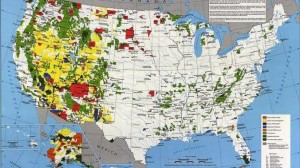How much land should the government own? Most westerners don’t give it much thought, but stoically accept the reality that government owns almost all of the land around us. But in the nation’s capital there is a serious debate underway about it, for the first time in a century.
The LWCF expired in September, and there is an intriguing standoff in Congress, not about whether it should be reauthorized for several more years, but about whether to cancel it altogether. It is ironic that one of the most popular of all federal funding programs – because it funds things people actually want – is the subject of such heated debate. But LWCF is really just the excuse that triggered a festering argument. Just below the surface lie two prickly issues that have been smoldering for years.
First, the government owns 635 million acres of land, almost a third of the United States, nearly all of it in the West, much of it underlain with energy and other vital resources. That includes 250 million acres of BLM land, 193 million acres of national forests, 84 million acres of national parks, and 150 million acres of national wildlife refuges. Over 110 million acres of those lands are designated wilderness, not including all sorts of other management designations that prevent various uses of public lands – often without congressional approval. For example, the Fish and Wildlife Service manages 540 wildlife refuges, but also 38 wetland management districts and 36,000 “waterfowl production areas.” There are Research Natural Areas, Cultural Resource Sites, Historic Sites, Wild and Scenic Rivers, National Natural Landmarks, National Trails, National Marine Sanctuaries, Estuarine Sanctuaries, Biosphere Reserves, Western Hemisphere Shorebird Reserves, and Wetlands of International Importance.
Second, the government cannot manage the land it already owns, so many leaders question whether it still makes sense to buy more. The 2015 budget calls for purchase of 160 more parcels of land. Yet the Interior Department has a $20 billion backlog of deferred maintenance on land it already has. The Park Service estimates that nine of every ten miles of park roads are crumbling, along with unsafe bridges and 6,500 miles of trails needing repairs. And over 70 million acres of catastrophic fires attest to the utter failure of national forest management over the past decade.
The environmental lobby wants Congress to reauthorize LWCF to the tune of $900 million per year (triple the 2015 amount), but that seems unlikely at the moment. Some of those groups make at least part of their living off the program, by the way, buying land and then reselling it to the government at premium prices. But convincing Congress to simply renew a major land acquisition program – without at least some reform – is not only improbable, but unwise.
My own impression is that Congress ought to make the promise of funding important State projects a permanent part of the law, and perhaps use any federal portion to address the maintenance backlog.
A thinly-veiled part of this dispute is the political divide over whether government ownership is the only way, or even the best way, to preserve important landscapes. Beyond the obvious policy implications of government owning all the land, there is simply not enough money in the entire treasury to preserve all the remaining open space by buying it all.
Nevertheless, faced with a choice between better partnerships with landowners, or more federal land acquisition, the federal system invariably chooses the latter. I advised the congressional committee examining this issue that buying land just for the sake of public ownership was never the goal of LWCF. Taking care of lands the public already owns should come ahead of buying more.
(A version of this column first appeared in the Grand Junction Daily Sentinel November 6, 2015.)





Comments on this entry are closed.